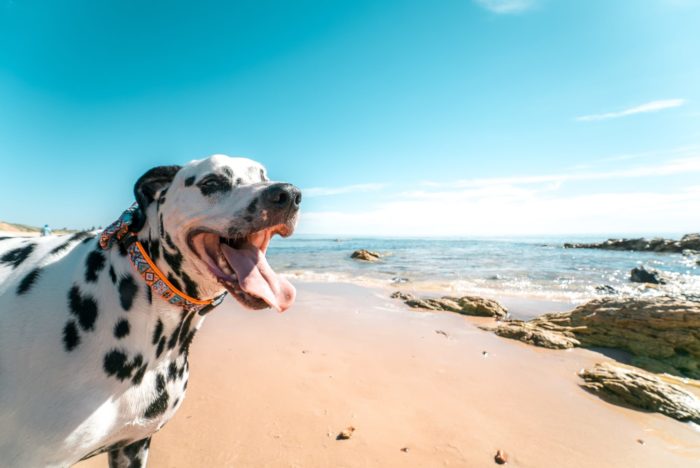Thanks to millennia of adaptive evolution, man’s best friend has become quite adept at handling the various forces of nature. Over this time, most canine breeds have developed various biological features or responses that help them mitigate inclement elements and leave them better equipped to handle extremes of either heat or cold.
That said, when it comes to extreme heat and cases of hyperthermia, there arises a high-temperature threshold where even the fittest of dogs are unable to regulate their body temperature to a tolerable degree. Not to be confused with hypothermia, which is a precipitous drop in body temperature, hyperthermia in dogs is defined as a body temperature surpassing 103.5°F. Easily mistaken for a fever, a case of hyperthermia can be a severe and life-threatening issue, so it is vital that you as a dog owner can identify the signs of hyperthermia.
Exogenous and Endogenous Causes of Hyperthermia

To differentiate hyperthermia and a fever, it is crucial that you understand the root causes behind the heat increase for both issues. In the case of a fever, the cause of heat elevation is endogenous (internal), and this body temperature increase happens when the canine’s immune system attempts to fight off infection or inflammation.
Not all that dissimilar from how they work in humans, a dog’s fever overheats the system to create an environment that discourages the development and survival of bacteria or viruses. Canine hyperthermia, on the other hand, is caused by exogenous (external) conditions, which result from environmental or ancillary factors. Such exogenous factors are often in the dog owner’s control or can at least be mitigated through self-awareness.
Signs of Dog Hyperthermia
The most obvious factor you should take into consideration is the current temperature around you. While not impossible, it is much harder for a dog to develop hyperthermia during cold seasons. However, in times of extreme warmth, your dog is more likely to become hyperthermic, especially if left in a hot car or an enclosed area that can heat up rapidly. If your dog is obese, has breathing issues, dark-thick fur, they may be predisposed to developing hyperthermia. If your pup is indeed suffering from this overheating, he or she will exhibit some, if not most, of these symptoms.
- Acute Kidney Failure
- Black, tarry stool
- Blood-clotting disorder(s)
- Bloody stool or diarrhea
- Breathing distress
- Cardiopulmonary arrest, stoppage of breathing and the heart
- Collapse
- Coma, the dog is incapable of being awakened or stimulated
- Dark red gums
- Death
- Death of liver cells
- Dehydration
- Breakdown of red-muscle tissue
- Excessive drooling, also known as ptyalism
- Fluid build-up in the lungs
- Generalized (systemic) inflammatory response syndrome
- Heavy panting in an attempt to cool down
- Hot to the touch
- Increased body temperature higher than 103° F
- Irregular heartbeats
- Little to no urine production
- Mental confusion
- Rapid heart rate
- Red flushed skin
- Seizures
- Shock
- Small areas of bleeding
- Tremors
- Vomiting, or vomiting blood
- Wobbly
Causes of Hyperthermia in Dogs
There are a variety of reasons or factors that may lead to a dog developing hyperthermia or predispose them towards overheating. Things to be aware of and on the lookout for include:
Excessive Environmental Heat and Humidity

The most obvious indicator that your dog could overheat are due to hot or humid weather conditions. While excessive heat should be your first indicator, it should be noted that being left enclosed in a car or an unventilated room can lead to hyperthermia, even on days when it is not unusually hot outside. According to Jan Null, a professor from SF State, “Children [and dogs] have died in cars with temperatures as low as 63 degrees. Basically, the car becomes a greenhouse.
At 70 degrees on a sunny day, after a half hour, the temperature inside the car is 104 degrees. After an hour, it can reach 113 degrees.” The CDC has studied this greenhouse phenomenon and wrote, “When the temperature outside ranges from 80 degrees to 100 degrees, the temperature inside a car parked in direct sunlight can quickly climb to between 130 to 172 degrees.” Studies have shown that even leaving the windows down does little to dissipate heat or prevent a car’s interior temperature from steadily rising. Because of this, it is essential to be mindful and avoid leaving your dogs in places that can quickly become hot boxes. Further, in times of extreme heat, avoid over exercising or overworking them.
Inability to Pant Efficiently
Dogs pant in order to blow off heat and cool down. While they can sweat, their primary cooling method is panting. If they have an upper airway disease that inhibits breathing and affects the nose, throat, windpipe, and nasal passages, they may be incapable of panting in a manner which allows them to effectively regulate their body temperature.
Toxin Poisoning
As you likely know, dogs will often eat anything that is put in front of them, and many things that are not; they can get into places where they should not be and decide that they are great locales for a snack. Certain toxins, such as snail bait, medicines, antidepressants, strychnine, compost, rotted food, and chocolate, can cause seizures or tremors that can lead to a hyperthermic response. We have seen cases of dogs developing a tremorless form of hyperthermia as a result of hops poisoning, where the dog at the hops from homemade beer brewing kits.
Treatment of Hyperthermia in Dogs
At a vet, treatment includes the following:
- Aggressive cooling down
- Anti-diarrheal medication
- Anti-seizure medication if needed
- Anti-vomiting medicines
- Antibiotics
- Blood pressure and heart rate monitoring
- Blood work monitoring
- Cool intravenous (IV) fluids
- Plasma transfusions
- Symptomatic supportive care
- Thermoregulation
If your dog is manifesting symptoms of hyperthermia, act quickly and decisively by taking them to a vet; however, if you are unable to for whatever reason, cooling down the dog should be your first priority. Using either ice packs, ice baths or cold rinses, do whatever you can to get their temperature below 103.5 degrees. Besides that, as an owner, you can help prevent hyperthermia by trimming your dog’s fur in the summer, making sure it is healthy (not obese) while simultaneously avoiding over exercise.




